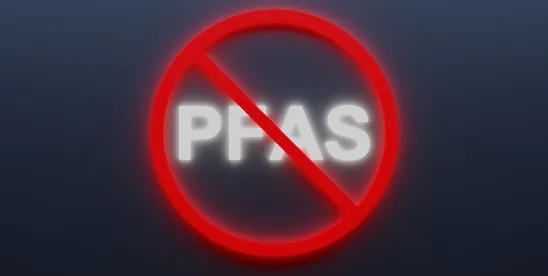On April 19, the U.S. Environmental Protection Agency (EPA) released its long-awaited final rule designating perfluorooctanoic acid (PFOA) and perfluorooctanesulfonic acid (PFOS), including their salts and structural isomers, as “hazardous substances” under Section 102(a) of the Comprehensive Environmental Response, Compensation, and Liability Act (“CERCLA” or “Superfund”) (the “Final Rule”). The designation, which takes effect 60 days after the final rule is published in the Federal Register, will provide expanded investigation and remediation authority to EPA, will provide a powerful tool for private actions under CERCLA, and will trigger additional release reporting requirements. It will also expand enforcement authority in states that regulate CERCLA-designated hazardous substances.
Hazardous Substance Designation of PFOA and PFOS Has Broad Implications for Cleanups and CERCLA Liability
PFOA and PFOS are two specific chemical compounds within a broad group of thousands of manmade chemicals known as per- and polyfluoroalkyl substances (PFAS). EPA focused its regulatory efforts on these two PFAS; however, the vast majority of PFAS remain unregulated under CERCLA even after issuance of the Final Rule.
Designating PFOA and PFOS as hazardous substances triggers numerous requirements. The primary impact of the Final Rule is that it incorporates PFOS and PFOA into CERCLA’s strict, joint and several liability framework. This change grants EPA the power to investigate releases of PFOA and PFOS and compel potentially responsible parties (PRPs), including owners and operators of a property or facility, to remediate releases of PFOA and PFOS through the specific CERCLA enforcement provisions. PRPs also now have a clear private right of action under CERCLA to pursue cost recovery and contribution actions. Additionally, when the Final Rule becomes effective, facilities will be required to immediately report releases of PFOA and PFOS above their designated “reportable quantities,” (currently one pound within a 24-hour period), to the National Response Center and relevant state or tribal authorities.
Furthermore, many states include CERCLA hazardous substances under their cleanup statutes, meaning these states will now be able to require remediation of PFOA and PFOS under state law.
Listing PFOA and PFOS as “hazardous substances” under CERCLA does not make PFOA or PFOS contaminated waste a “hazardous waste” or a “hazardous constituent” under the Resource Conservation and Recovery Act. However, this designation does require the U.S. Department of Transportation to designate PFOA and PFOS as “hazardous materials” for purposes of transport under the Hazardous Materials Regulations.
While the PFOA and PFOS CERCLA Listing is Final, Questions Remain
As noted in our prior article on the proposed rule, EPA’s designation of PFOA and PFOS as “hazardous substances” leaves several questions unanswered.
- How will EPA’s CERCLA enforcement discretion policy really play out in practice?
Concurrently with the publication of the Final Rule, EPA also released a PFAS Enforcement Discretion and Settlement Policy under CERCLA. This enforcement policy captures EPA’s current position that it does not intend to pursue PRPs under circumstances where “equitable factors” do not support doing so. Enumerated circumstances in the policy include so-called “passive receivers” of PFAS, including community water systems and publicly-owned treatment works, publicly-owned municipal solid waste landfills, publicly-owned airports and local fire departments, and farms where PFAS-containing biosolids are applied to the land. However, EPA’s enforcement policy—which is not binding upon the agency and is subject to change at any time—should be viewed with a healthy dose of skepticism among regulated industries, considering the sheer breadth of potential CERCLA liability for these substances, as well as continued Congressional proposals to codify exemptions for passive receivers within the CERCLA statute itself. Notably, the agency’s enforcement position does not in any way prevent private parties from initiating cost recovery or contribution actions under CERCLA.
- How will regulated industries manage the costs of PFOA and PFOS cleanup?
PFAS contamination can be wide-ranging due to several factors unique to the chemicals themselves. Further, unlike remediation technologies for other well-studied contaminants, existing remediation technologies for PFOA and PFOS are nascent at best and are expensive at a large scale. It is therefore often difficult to even estimate accurate cost ranges for PFOA and PFOS cleanups, but costs can easily run into the millions of dollars at complex sites. Although EPA has published interim guidance on PFOA and PFOS disposal methods, and the recently passed Infrastructure Investment and Jobs Act provides $3.5 billion over five years for Superfund cleanups, the methods and money may not go as far as planned if cleanup costs for PFOA and PFOS sites end up exponentially higher.
- How will EPA handle potential PFOA and PFOS contamination at closed Superfund sites?
In response to comments seeking clarification on whether designating PFOA and PFOS will lead to the reopening of closed Superfund sites, EPA stated that the final rule “has no impact” on EPA’s authority to list PFOA and PFOS sites as Superfund sites. EPA’s question-and-answers page—which we note is not a binding statement from the agency—also states that “[d]esignation will not change EPA’s process for listing and/or deleting [National Priorities List (NPL)] sites or evaluating remedies’ protectiveness through five-year reviews, and it will not require PFOA and PFOS sampling at NPL (final or deleted) sites.” While the final rule does not require PFOA and PFOS sampling at closed sites, it does not prevent EPA from ordering sampling at these sites. PRPs who may have long ago stopped budgeting for remedial costs at existing or legacy locations that were remediated years and even decades ago, may find that they are required to revisit these sites where PFOA and PFOS may be present.
- What cleanup standards will govern PFOA and PFOS remediation?
There is a current patchwork of state regulatory standards relating to PFAS, ranging from binding cleanup levels, advisory guidance, or no PFAS standards at all, which may lead to similarly patchwork cleanup standards depending on which standards are applied as an appropriate “applicable or relevant and appropriate requirement” (ARAR) at a specific site. In addition, on April 10, 2024, EPA issued a final rule setting Maximum Contaminant Levels (MCL) for PFOA and PFOS in drinking water at 4.0 parts per trillion (ppt), individually. While these drinking water standards are separate from EPA’s final rule listing PFOA and PFOS as “hazardous substances” under CERCLA, the “hazardous substances” rule notes that the MCL may be an appropriate ARAR for cleanup efforts under CERCLA.
- What other PFAS will EPA next target under CERCLA?
As noted above, PFOA and PFOS are two specific PFAS among thousands of others currently and historically used. Much of the science on the potential health effects of PFAS (both individual chemical compounds and as a class) continues to evolve. In the meantime, EPA has moved to regulate additional types of PFAS under other statutes. For example, as we noted in a previous client alert, EPA recently published a proposed rule listing seven other PFAS compounds as hazardous constituents under RCRA. Some or all of these PFAS may eventually be targets of future CERCLA rulemaking efforts.
Next Steps
The Final Rule will take effect 60 days after it is published in the Federal Register. Affected parties should consider their portfolio of planned, active, and in some cases, closed remediation sites for potential implications, and companies may consider reviewing and updating their hazardous substance reporting and transportation protocols to address PFOA and PFOS as applicable.









 />i
/>i

